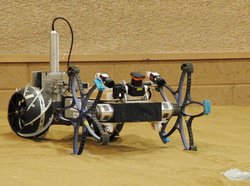Coyote II
High Mobile Micro Rover
Technical Details
| Size: | 850 x 516 x 415 mm |
| Weight: | 9,2 kg 13,7 kg with soil sensor payload |
| Power supply: |
Primary Battery: LiPo – 44.4 V; 2.1 Ah, Bus Voltages: 48 V, 12 V, 5 V
|
| Speed: | 0.65 m/s |
| Actuation/ Engine: |
4-Wheel drive: Robodrive ILM 50x8 brushless dc-motor with Harmonic Drive gearing (100:1)
|
| Sensors: |
- Laser range finder: Hokuyo UTM-30XL
- Stereo camera: 2x AVT F33B (horizontal FoV: 118.6°)
- IMU: Xsrens MTi-300 AHRS
|
| Communication: |
Mobile access point: 2.4 GHz, 802.11n, Bluetooth (remote control)
|
| On-board computer: |
IntelCore i7-3517UE, 1.7 GHz
|
| Struktur und Mechanismen: |
Doppeldeckerstruktur basierend auf Sandwichplatten (Aramid + Arix), Fahrwerk: Passives Rollgelenk an Hinterachse, mechanisch abkippbare Hinterachse
|
Organisational Details |
|
| Sponsor: | European Union |
| Grant number: | Funded by the European Union FP7-SPACE SPA.2011.2.1-02 GA284419 |
| Application Field: | Space Robotics |
| Related Projects: |
FASTER
Forward Acquisition of Soil and Terrain data for Exploration Rover
(11.2011- 11.2014)
|
| Related Robots: |
ASGUARD I
Advanced Security Guard V1
ASGUARD II
Advanced Security Guard V2
ASGUARD III
Advanced Security Guard V3
ASGUARD IV
Advanced Security Guard V4
CESAR
Crater Exploration and SAmple Return
|
System description
Coyote II is a micro rover with high mobility performance in various terrains. Equipped with its own power source, on-board sensor suite and computer it is able to perform autonomous exploration tasks. The communication subsystem allows to cooperate with other systems and provides a link for remote control. Due to the robust structural design and powerful actuators, Coyote II is able to carry several kilograms (> 6 kg) of payload.
A special characteristic of Coyote II is its novel locomotion concept. It combines the high mobility performance of hybrid legged-wheels (in the front) with the smooth wheel movement of spherical helical wheels (in the rear). Therefore, the scout rover is able to move on soft soil as well as on unstructured terrain and can perform side-to-side steering movements. It is however, possible to mechanically tilt the rear axis in a horizontal position allowing to operate Coyote II with four equally shaped wheels in the front and rear.
Within the FASTER project Coyote II acts as scout rover with the aim to improve the mission safety and the effective traverse speed for planetary rover exploration. To avoid uncertain estimations concerning the trafficability of the areas to be explored, the scout rover provides suitable information on the terrain ahead of a primary exploration rover. To handle this task Coyote II is equipped with an additional soil sensor payload. This contains first, a Wheel-Leg Soil Interaction Observation (WLSIO) system and second, a motorized Dynamic Cone Penetrometer (mDCP). Both sensor systems are developed by Surrey Space Center.



